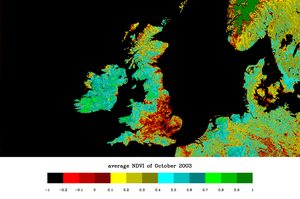常态化差值植生指标



归一化植被指数(Normalized Difference Vegetation Index;NDVI)又译标准化植被指数、常态化差值植生指标,是一个数值指标,通常(但不一定)是从太空来作观测,用于分析遥感观测所得到的信息。NDVI通常是用卫星遥感数据计算,以评估目标地区绿色植被的生长状况。
计算方式是利用红光与近红外光的反射,能显示出植物生长、生态系的活力与生产力等信息。数值愈大表示植物生长愈多。公式如下:
NIR为近红外光反射;RED为红光反射,NDVI之值介于-1到1之间。 当RED=0时,有最大值1;反之,当NIR=0时,有最小值-1。

